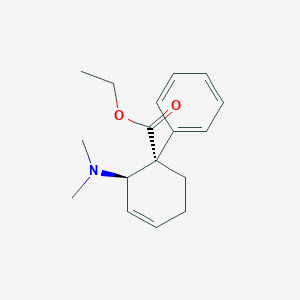Details of the Drug
General Information of Drug (ID: DMJW0VS)
| Drug Name |
Tilidine
|
|||||||||||||||||||
|---|---|---|---|---|---|---|---|---|---|---|---|---|---|---|---|---|---|---|---|---|
| Synonyms |
Valoron; Tilidine hydrochloride hemihydrate; 255733-17-6; Tilidine hydrochloride hemihydrate [EP]; DTXSID70180262; Ethyl (1RS,2SR)-2-(dimethylamino)-1-phenylcyclohex-3-enecarboxylate hydrochloride hemihydrate; 3-Cyclohexene-1-carboxylic acid, 2-(dimethylamino)-1-phenyl-, ethyl ester, hydrochloride, hydrate (2:2:1), (1R,2S)-rel-; UNII-Y757T3419R component WHYVWQHDUOALSV-UMJMSJQKSA-N
|
|||||||||||||||||||
| Indication |
|
|||||||||||||||||||
| Drug Type |
Small molecular drug
|
|||||||||||||||||||
| Structure |
 |
|||||||||||||||||||
| 3D MOL | 2D MOL | |||||||||||||||||||
| #Ro5 Violations (Lipinski): 0 | Molecular Weight (mw) | 273.37 | ||||||||||||||||||
| Topological Polar Surface Area (xlogp) | 3.1 | |||||||||||||||||||
| Rotatable Bond Count (rotbonds) | 5 | |||||||||||||||||||
| Hydrogen Bond Donor Count (hbonddonor) | 0 | |||||||||||||||||||
| Hydrogen Bond Acceptor Count (hbondacc) | 3 | |||||||||||||||||||
| ADMET Property |
|
|||||||||||||||||||
| Chemical Identifiers |
|
|||||||||||||||||||
| Cross-matching ID | ||||||||||||||||||||
Molecular Interaction Atlas of This Drug
 Drug Therapeutic Target (DTT) |
|
||||||||||||||||||||||||||
|---|---|---|---|---|---|---|---|---|---|---|---|---|---|---|---|---|---|---|---|---|---|---|---|---|---|---|---|
| Molecular Interaction Atlas (MIA) | |||||||||||||||||||||||||||
References
